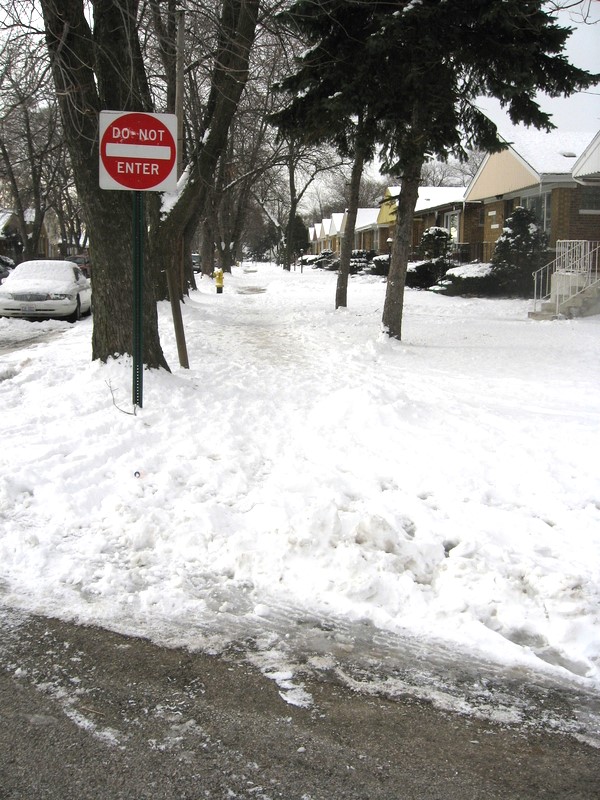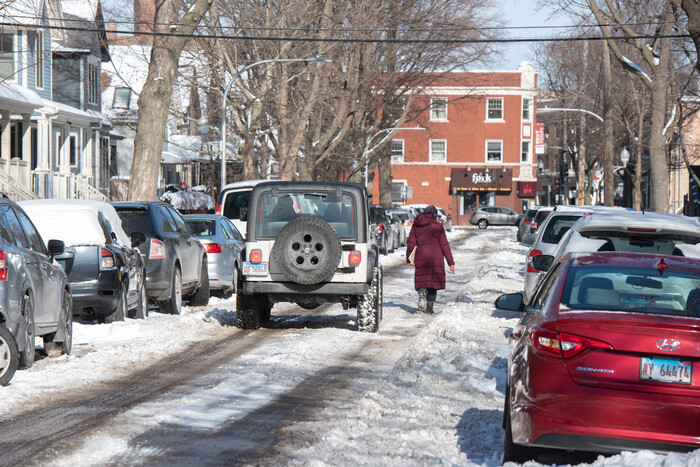Did You Know?
Plow the Sidewalks pilot program takes a step forward

After many decades of policies that have fallen far short of keeping our sidewalks clear of snow in the winter, Chicago is on the verge of vast improvements when it comes to enhancing mobility when the snow falls.
In July, Better Streets Chicago and Access Living’s Plow the Sidewalks Pilot Program ordinance passed in city council 49-1. The ordinance approved the formation of a committee that will establish zones of the pilot program by May 2024 before expanding citywide.
Once the pilot expands into a city-wide program, it will be an enormous benefit to people with disabilities, senior citizens, and families with strollers and children, as well as delivery workers and anyone who needs access to sidewalks as a means of transportation and exercise.
The current snow clearing policy states that any property owner, lessee, tenant, or other relevant person is responsible for removing snow and ice from any sidewalk abutting their property.
In other words, there’s a large number of different people responsible for an assortment of short stretches of sidewalks, and when the sidewalk doesn’t get shoveled, those responsible are subjected to fines, although citations are inconsistent and sparsely issued.
The ordinance was spearheaded by Better Streets Chicago, a grassroots group that works toward healthier, more equitable transportation options, and Access Living, a disability rights organization.
One of the reasons why the old policy isn’t working for the city, says Kyle Lucas of Better Streets Chicago, is that “fining doesn’t shovel a sidewalk.”
A sidewalk, he said, can go unshoveled for a variety of reasons. Elderly or disabled people could be physically unable to shovel and unable to pay someone to clear the snow for them. Someone could be out of town or sometimes people just can’t be bothered.
Additionally, the old policy fails to take into consideration gaps in coverage, such as bus shelters, highway underpasses and viaducts, bridges, industrial sites, vacant properties, or just any place that isn’t privately owned.
The problem with these gaps is that they create unusable sections of the sidewalk that ultimately limit accessibility to one of Chicago’s biggest transportation systems. And the city needs to ensure that all residents can get around safely, regardless of their mobility needs.

“The city clears the streets for drivers. But the sidewalk is part of the public way, and it should be the city’s responsibility to take on this task as well,” says Lucas. “It is a really big thing to take on and that’s why we have a government. They’re the ones who are responsible for taking care of those really big things that are not things for individuals to take care of.”
The goal of the Plow the Sidewalks Pilot Program ordinance is to fix these gaps and increase mobility in Chicago during the winter.
When the snow and ice pile up on the sidewalks, our neighbors with disabilities are trapped in their homes because they are unable to roll a wheelchair to get to doctor’s appointments, to pick up groceries, or even to meet up with friends.
Lucas says that “everyone needs to be a part of the community,” and when the snow is covering the ground for weeks on end, they are left out.
“If you’re a wheelchair user, you can’t get through. If you’re blind, you can’t get through. And also, if you’re blind or low vision and you can’t get through, you probably won’t be able to tell that immediately,” Laura Saltzman from Access Living. “You’ve now walked part of the way down the sidewalk and now you have to walk back and take up to three or four times [the amount of time] to get wherever you need to go.”
The local economy also takes a hit during the winter months because tourism becomes less appealing when it is challenging and unpleasant to get around. Municipal sidewalk clearance can help improve Chicago’s revenue collection.
Toronto, Montreal, and even other municipalities in Chicagoland such as Forest Park have taken responsibility for plowing the sidewalks.
The Chicago ordinance establishes a working group to be made up of people from various departments, such as the Chicago Department of Transportation offices for people with disabilities, City Council Chair of the Committee of Pedestrian and Traffic Safety, and the Chicago Streets and Sanitation Department.
The committee will plan a pilot program that will be presented to the City Councils Committee of Pedestrian and Traffic Safety, before being presented to city council.
The group will use the responses from community feedback and engagement to establish where the pilot zone will be located and what kind of snow clearing equipment will be needed to make the sidewalks as safe and accessible as possible.
The pilot zone will be decided by considering where people with disabilities live, with special attention given to the South and West Sides of the city. Lucas says that one of the goals of the ordinance is “to ensure that equitability is at the center of it.”
Independent of the committee that will establish zones of the pilot program, Better Streets Chicago developed an analytical tool to help explore potential pilot zones. The tool, they said, is presently only for demonstration purposes.
Part of the pilot program is a study that will provide recommendations for next steps and give the city a chance to work through any operational challenges such as sidewalks that need to be repaired before they can be easily plowed. The plan is also to ultimately expand citywide.
Besides operational challenges, Lucas said one of the biggest barriers was overcoming the different viewpoints held by city council members.
“There are some folks who didn’t believe in it early on and then came around to it later, after they continued to hear about it and thinking about it from a different perspective,” says Lucas.
“We’re really, really fortunate that we had great leaders who were helping us out,” says Lucas, noting that Alderman Gilbert Villegas and Mayor Brandon Johnson deserve praise for joining the cause.
In order to ensure the program continues moving forward, Saltzman urged Chicagoans to call their alderpeople to make sure they support the campaign.
“It is truly a great demonstration of what happens when you come together and organize and make changes that make our communities better,” says Lucas. “Chicago deserves to see this happen, and we are feeling really hopeful.”
Olivia Borowiak is an intern for the Active Transportation Alliance.
Make a Donation
Your tax-deductible donation supports the important work that Active Trans does throughout the region
